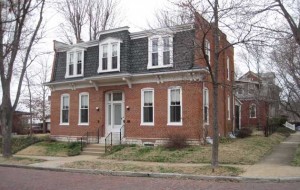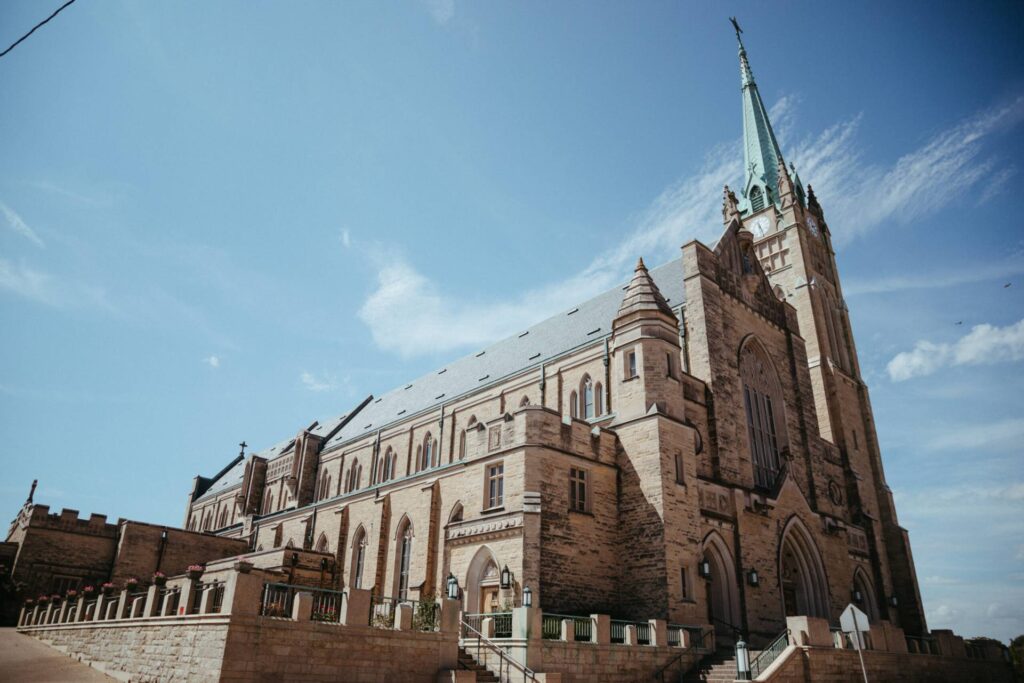
These resources can help you learn more about the history of homes and buildings in Belleville, Illinois, including archival maps and photos and previous owners and residents. Information compiled by historian Bob Brunkow.
Spotlight Research: Cathedral of St. Peter
The Cathedral of St. Peter in Belleville is the largest cathedral in Illinois. It was built in the early 1860s and constructed of brick and modeled after the Cathedral in Exeter, England. It was dedicated as St. Peter Catholic Church in 1866. The priests were German and the services were spoken in Latin and German. When the Diocese of Belleville was established in 1887, it became known as the Cathedral of St. Peter. A fire in 1912 gutted the building and destroyed the roof. Even though the church interior and roof were rebuilt, the damaged pews were donated to the Corpus Christi Catholic Church in Shiloh, which was under construction at the time. Due to the continued deterioration of the brick mortar joints due to the 1912 fire, the decision was made in 1957 to resurface the church with limestone. The south nave was added in 1966, bringing the church to its current configuration.
If you would be interested in seeing one of the fire-damaged pews from the Cathedral, schedule a tour of Belleville Historical Society’s Historic Garfield Street Saloon Museum with our historian, Bob Brunkow. You can reach him at 618/236-7481 or email at rdevb@earthlink.com. Leave a message and he will call you back.
(Photo courtesy of the Cathedral of St. Peter website: https://cathedralbelle.org/)

Ownership
In a perfect world, when you bought your home you acquired a title abstract that listed all the previous owners of the property. In reality you probably just know who the last owner was. Tracing back ownership from this one piece of information is possible using resources in the Belleville Pubic Library and the Recorder of Deeds Office on the fifth floor of the St. Clair County Courthouse. The most recent deeds are available on-line in the Recorder of Deeds Office. To find the previous owners you need to enter the parcel number in the appropriate box on the Recorder of Deeds computers. The on-line records extend back to the 1990’s. For earlier owners, you will need to look at the microfilm grantor (seller)–grantee (buyer) indexes. In addition to the name of the owner you need to find the legal description of the property, e.g., Lot 4, Stuart and Phillips’ Addition. The indexes are in the Recorder of Deeds Office. The grantor-grantee indexes to about 1910 are available and easier to research at the library. The indexes are arranged alphabetically by the seller’s name in the grantor index and by the buyer’s name in the grantee index.
Normally, researchers work backwards, from the most recent grantee. Search the grantee index for the entry that shows both the grantee’s name and the legal description of the property. That entry will also identify the grantor who sold the property to the grantee. Repeat the research steps. This time search the grantee index using the new name of the grantor you found on the previous deed. As in the previous search, the entry that has both the name of the grantee and the legal description will provide the name of the grantor. Continue to work backwards from grantee to grantor until you find the original deed.
What happens if you do not know the names of the grantees or grantors? Using the legal description, try working forward from the first sale of the property in the addition, e.g., Stuart and Phillips’ Addition. Especially for the early additions, the one or two people who platted the addition gave their names to it. Theodore Hilgard, for example, was the original grantor of Hilgard’s Fourth Addition. Using his name and the legal description check the grantor index until his name and the description appear in the index entry. That entry will identify the grantee. To find the next sale search for that name in the grantor index until that name and the legal description line up in the entry, which also provides the name of the next grantee. Repeat the search until you end with the current grantee.
Do not be satisfied with the list of grantors and grantees from the index. Check the microfilm deeds in the Recorder of Deeds Office. The indexes do not always give complete information. Sometimes they are in error. Always they use the date the deed was recorded. Sometimes the property was sold years before the deed was recorded, a fact unknown until the original deed is checked.
Houses
Your list of grantors and grantees is a list of the owners of the lot, not necessarily a listof homeowners. Lots often changed hands many times before someone built on them.
Several steps should help to identify the original house owner and approximate age of the house. Often the deed will provide the price of the property. A major change in price between two deeds may indicate when a house was built—another reason to check the actual deeds. A first mortgage may also indicate new construction. The Recorder of Deeds has mortgage indexes that work just like grantor-grantee indexes, except that the borrower is the grantor, and the lender is the grantee.
Maps also help to determine the existence of homes. Map of St. Clair County, Illinois (1863), available online and at the public library, includes a map of Belleville on the overview page of the county that shows which lots had buildings on them in 1863. (Of course the building now on the lot could be of later construction.) The Bird’s-eye View Map of Belleville (1867), available on the Library of Congress website, has drawings of the town’s buildings. The Sanborn Fire Insurance Maps were published periodically from 1884 to 1949. They depict the footprints of buildings. They are available on microfilm at the library and digitally, through the 1917 map, through the University of Illinois Library’s Digital Collections. A comparison of the maps over time will reveal how a building’s configuration changed.
Contemporary photographs of buildings in portions of the Old Belleville Historic District along with some history are in Jane Eiseley, Belleville Intensive Survey of Historic Buildings (1995), available in the library. Greater Belleville (1910), available in the library, and at the Internet Archive website, has numerous photos of buildings. Though difficult to reproduce, photos are also available in the Belleville News Democrat Centennial Edition (1914) in the library and also in the St. Clair County Historical Society. The entire photo collection of the Labor & Industry Museum is available in the Online Collections Database.
A good source of information on architectural styles and construction is McAlester and McAlester, Field Guide to Houses, available in the library.
Residents
Your list of grantors and grantees does not necessarily tell you who lived in your house. Some owners were only investors. For information on residents, a check of City Directories is advisable. These list the names, addresses, and, until recently, occupations of residents. The library has the largest collection of these and has made available digitized editions of the earliest City Directories on the library website. They have been published periodically since 1860. The 1915 city directory (available only on the website) was the first to list residents by address. The 1925 directory was the first to identify residents who owned the property, providing a shortcut to find the first owner.
With the names that come from the city directories, sources in the previous paragraph, and the deeds you will acquire a list of people who can be tracked in the newspapers. The WPA Index of Newspapers, 1840-1940 in the library provides ready access to the library’s microfilm newspapers. Note that the Belleville News-Democrat is indexed only by exception in the 20th century, but the News-Democrat is digitally accessible from 1900 to the early 1950s at the public library or from your personal computer if you have a Belleville library card. The online newspaper edition is also accessible from the St. Clair County Genealogical Society members’ site. Local German newspapers are also on microfilm at the Belleville Public Library.
Census returns are key documents for determining people of interest. Ancestry.com is a fee-website that has a database of censuses as well as immigration documents and religious records. It can be accessed for free at the Belleville Public Library. FamilySearch is a free site for censuses and other material available at Ancestry.com. It does require that the user register.
Almost an original primary source is the 1881 St. Clair County History. Diane Renner Walsh, St. Clair County, Illinois: Research and Resources, A Genealogist’s Guide, is a comprehensive handbook on the types of genealogical sources available.
Repositories
The Belleville Public Library has the largest collection of material on Belleville history. Belleville’s Labor and Industry Museum has photos and documents of buildings and Bellevillians. The St. Clair County Historical Society also has much information. The St. Clair County Genealogical Society does not have an independent repository but its website, and publications available in the library offer extensive information on Bellevillians. A membership in the society makes accessible private areas of the website.
You must be logged in to post a comment.